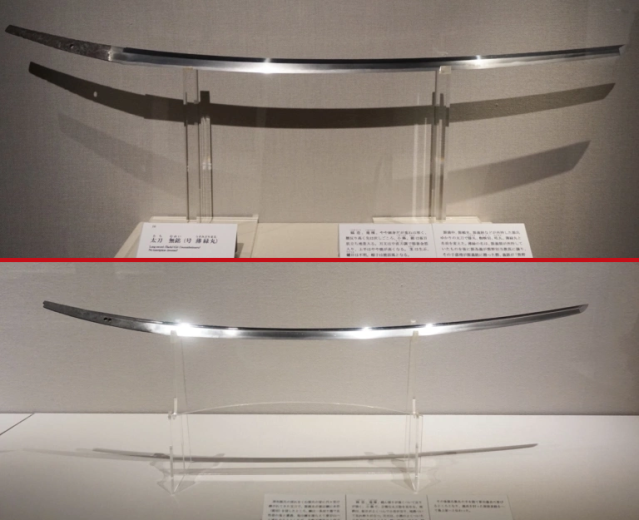
Two of Japan’s most beautiful blades are said to be linked at birth, but a closer look makes some scholars think twice.
Any guidebook will tell you that Nara is a great place to go if you want to see temples or deer, as the central Japanese city has plenty of both. However, right now Nara is also a must-visit if you want to see katana.
Kasuga Shrine, located inside Nara Park, is currently hosting an exhibition in its attached museum called The World of the Oldest Japanese Swords, with a special focus on the works of Yasutsuna, one of the most revered swordsmiths of the Heian period (794-1185) of Japanese history.
Of particular interest are two blades collectively known as the “Brother Katana:” Yasutsuna’s Higekiri and Hizamaru.
▼ Higekiri (top) and Hizamaru (bottom)
So how did they become known as the Brother Katana? The most commonly accepted explanation is that both blades were commissioned by Minamoto no Mitsunaka, a samurai descendant of Emperor Seiwa who was born circa 912.
The swords have a few other things in common too, such as the fact that they both have multiple names. Starting with Higekiri, it got it’s first name because of the practice of tameshigiri, testing out newly made katana on the bodies of criminals. Higkiri was so sharp that it was said during testing even the beards (hige) of convicts were sliced (kiri). Later, the sword acquired a much more heroic-sounding name: Onikirimaru (“Demon Slayer”), with an accompanying legend claiming it was used to slice off a demon’s arm.
▼ Higekiri/Onikirimaru
Hizamaru was also tested by tameshigiri, this time with the results being severing at the knees hiza. Once again, later legends attribute more glorious deeds to the weapon, this time being used to slay a giant spider called Yamagumo, earning it the name Tsukomikiri.
▼ Hizamaru/Tsukomikiri
However, there’s a mystery that surrounds the Brother Katana. While historians agree that they were both made in the Heian period, only Higekiri bears Yasutuna’s mark on its tang (the core of the hilt). Hizamaru, on the other hand, bears no smith’s signature, which is unusual for a katana of such quality.
Because of this, some scholars speculate that Hizamaru isn’t actually Yasutuna’s work, and is instead the creation of some other smith. Sure enough, when we took a close look at the two blades to compare them we spotted some differences.
One of the first things to look for when visually inspecting a katana is the hamon, or temper marks. For Higekiri, the hamon appear as irregular, undulating waves. Hizamaru’s hamon, though, is far straighter, looking like surface of a calm lake.
▼ The hamon of Higekiri (top) and Hizamaru (bottom) can be seen near their cutting edges.
Another thing to check is the jigane, the grain and folding lines that are thought of by appraisers as the “skin” of the sword. Again, the two Brother Katana show differing styles, with Higekiri showing distinct fold lines, and Hizamaru a smoother grain and a liquid-like shine.
Because the hamon and jigane are intrinsically tied to the manner in which the smith makes the sword, it would be unusual, though not impossible, for so much variation to be present between two weapons from the same craftsman. For example, look at Tenkomaru, another confirmed Yasutsuna sword on display at the exhibition.
The wavy hamon of Tenkomaru looks close to that of Higekiri, meaning that if Hizamaru was indeed made by Yasutsuna, it’s the odd katana out of the set of three.
But if Hizamaru isn’t a Yasutsuna blade, then who was it made by? One theory is that it’s the work of yet another legendary swordsmith: Sanjo Munechika, the same man who made the Mikazuki, one of the fabled Five Swords Under Heaven. The exhibition just so happens to be displaying a sword crafted by Munechika’s grandson, Arishige, called Ishikirimaru, which has a design indicative of the family style.
Just like with Hizamaru, Ishikirimaru has a relatively straight hamon and smooth jigane.
Unfortunately, since all of these confirmed or hypothesized katanaka makers lived centuries ago, we can’t ask them to definitively solve the mystery for us. If you’d like to gaze upon these works of art while contemplating the possibilities yourself, though, Higekiri and Hizamaru will be on display until January 26, with the overall exhibition itself running until March 1.
Event information
The World of the Oldest Japanese Swords / 最古の日本刀の世界
Venue: Kasugataisha Museum / 春日大社国宝殿
Address: Nara-ken, Nara-shi, Kasuganocho 160
奈良県奈良市春日野町160
Open 10 a.m.-5 p.m.
Admission 1,000 yen (US$9)
Exhibition until March 1
Website
Photos: ©SoraNews24
● Want to hear about SoraNews24’s latest articles as soon as they’re published? Follow us on Facebook and Twitter!
[ Read in Japanese ]
Follow Casey on Twitter, where people have been telling him that he and his brother look nothing alike for their entire lives.